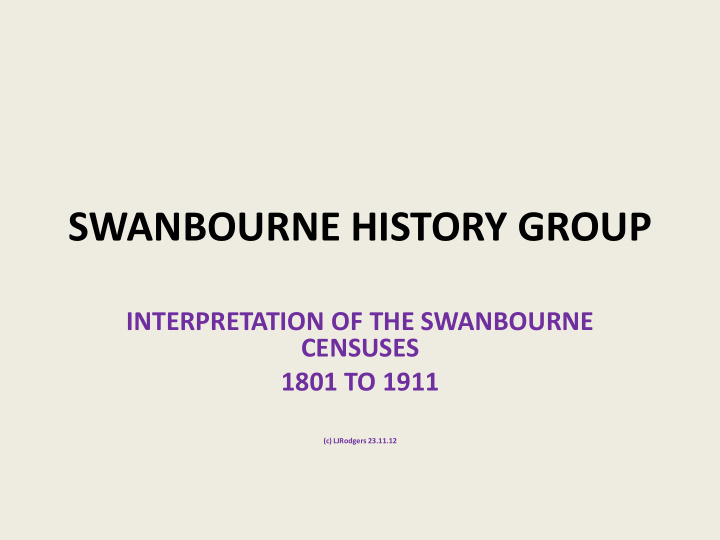



SWANBOURNE HISTORY GROUP INTERPRETATION OF THE SWANBOURNE CENSUSES 1801 TO 1911 (c) LJRodgers 23.11.12
What is a Census? Definition from the Office of National Statistics: • Every ten years since 1801 the nation has set aside one day for the census - a count of all people and households. It is the most complete source of information about the population that we have. The latest census was held on Sunday 27 March 2011. • Every effort is made to include everyone, and that is why the census is so important. It is the only survey which provides a detailed picture of the entire population, and is unique because it covers everyone at the same time and asks the same core questions everywhere. This makes it easy to compare different parts of the country. • The information the census provides allows central and local government, health authorities and many other organisations to target their resources more effectively and to plan housing, education, health and transport services for years to come. • In England and Wales, the census is planned and carried out by the Office for National Statistics. Elsewhere in the UK, responsibility lies with the National Records of Scotland and the Northern Ireland Statistics and Research Agency.
John Marius Wilson – Imperial Gazetteer of England and Wales 1870-1872 SWANBOURNE is described as: a parish, with a village, in Winslow district, Bucks; near the Oxford and Bletchley railway, 2 miles E by S of Winslow. It has a station on the railway, and a post- office under Winslow. Acres, 2,510. Real property, £5,034. Pop., 603. Houses, 139. The property is subdivided. The manor, with S. House, belongs to Sir T. F. Fremantle, Bart. The living is a vicarage in the diocese of Oxford. Value, £158.* Patron, Sir T. F. Fremantle, Bart. The church is ancient. There are a Baptist chapel, a national school with £15 a year from endowment, a straw-plaiting school, and charities £28.
Records of individual names were made from 1841 onwards. The Enumerator walks past the farms and in to the village, asking the inhabitants questions door to door and recording their answers.
The 1851 Census gives us more information than 1841
What does the 1911 Census tell us? The most detail is on the 1911 return. For each individual you can find out: • Name • Relationship to head of family • Age last birthday • Address (can be a little vague) • Marital status, and number of years married • Number of children and whether alive or dead • Occupation • Place of birth • Number of rooms in house
Hart House - details 1911
Pitkin Family - details 1911
Population of Swanbourne • 1801 529 800 • 1811 499 700 • 1821 616 • 1831 668 600 • 1841 679 500 • 1851 646 400 • 1861 603 • 1871 558 300 • 1881 474 200 • 1891 429 100 • 1901 405 • 1911 427 0 1801 1811 1821 1831 1841 1851 1861 1871 1881 1891 1901 1911 2011 • 2011 429
Analysis of Census information Things to note: • Occupational terms are subject to interpretation, but mean either source of income or social status • Ages in school – usually between 4 and 15 • Who doesn’t work? • Adult ages over the age of 15 usually rounded down to the nearest 5 on the 1841 Census
Other Occupations SEE EXCEL FILE
Victorian Straw Plaiters Luton was the centre for straw plaiting in Victorian times
Straw hats today are mostly made in…..China!
What next? • You can view the transcript of all of the Swanbourne Censuses on our new Website • You can use this information as a useful tool to develop your personal family history
The End
Recommend
More recommend